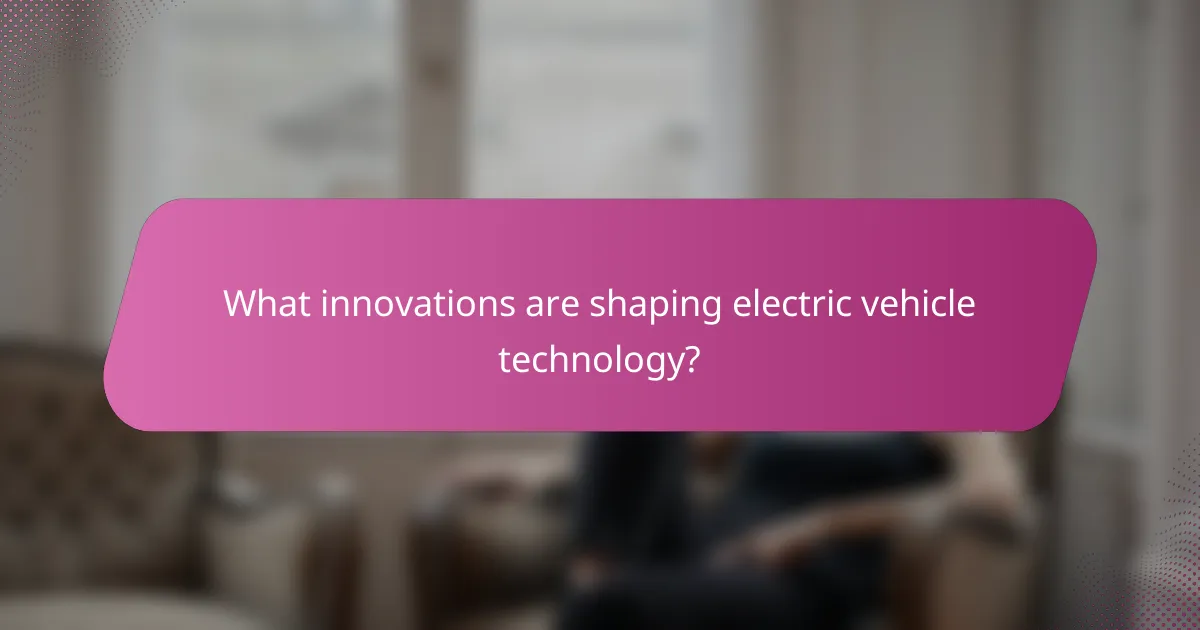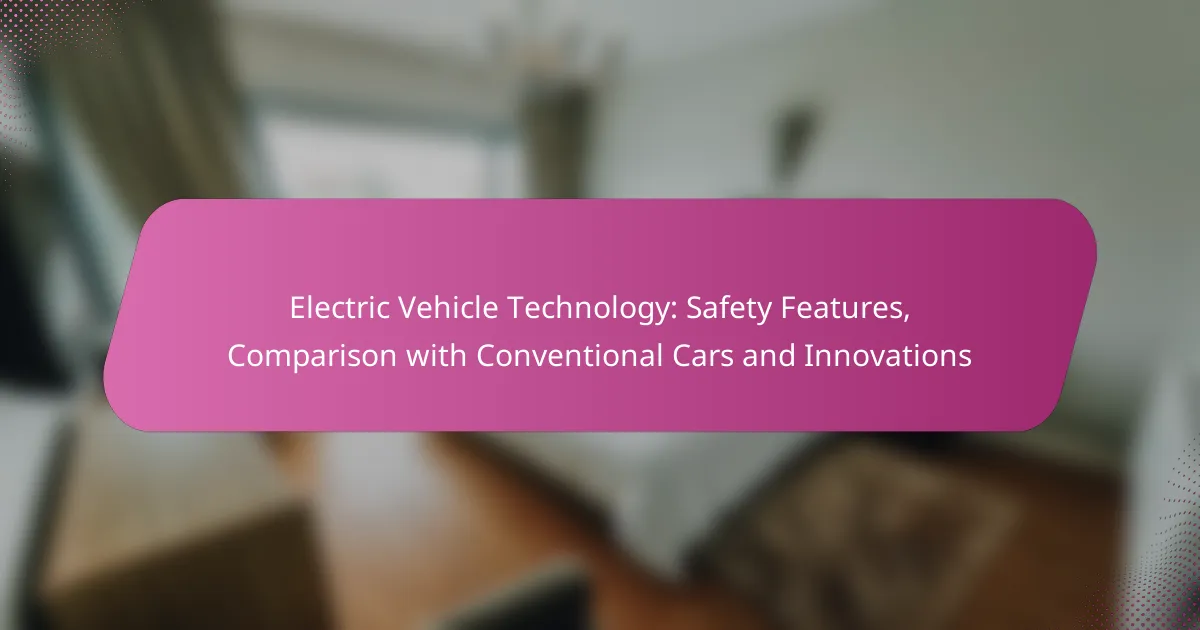Electric vehicles (EVs) are at the forefront of automotive innovation, integrating advanced safety features that often surpass those of conventional cars. With their reliance on electric motors and batteries, EVs not only offer distinct advantages in performance and environmental impact but also pave the way for groundbreaking technologies such as autonomous driving and smart charging solutions. As the industry evolves, these innovations continue to enhance user convenience and overall road safety.

What are the safety features of electric vehicles?
Electric vehicles (EVs) incorporate a range of safety features designed to protect occupants and enhance overall road safety. These features often surpass those found in conventional cars, focusing on advanced technology and innovative design.
Advanced Driver Assistance Systems (ADAS)
ADAS includes various technologies that assist drivers in avoiding accidents and improving safety. Features such as adaptive cruise control, lane-keeping assist, and automatic emergency braking are common in many electric vehicles.
These systems utilize sensors and cameras to monitor the vehicle’s surroundings, providing real-time feedback and intervention when necessary. For instance, if a potential collision is detected, the system can automatically apply the brakes to prevent an accident.
Battery Safety Technologies
Battery safety is crucial in electric vehicles due to the high energy density of lithium-ion batteries. Manufacturers implement several safety technologies, such as thermal management systems and battery management systems, to monitor battery health and prevent overheating.
In addition, many EVs are designed with protective casings to shield batteries from impact during collisions, significantly reducing the risk of battery failure or fire in an accident.
Crash Test Ratings
Electric vehicles undergo rigorous crash testing to evaluate their safety performance. Organizations like the National Highway Traffic Safety Administration (NHTSA) and the Insurance Institute for Highway Safety (IIHS) provide ratings based on various crash scenarios.
Many EVs achieve high safety ratings, often comparable to or exceeding those of traditional vehicles, thanks to their robust construction and advanced safety features. Consumers can refer to these ratings when considering the safety of different models.
Fire Resistance Measures
Fire resistance is a critical concern for electric vehicles, particularly regarding battery safety. Manufacturers implement several measures, such as fire-resistant materials and thermal barriers, to minimize the risk of fire in the event of a crash.
Additionally, many EVs are equipped with fire suppression systems that can activate automatically in case of a thermal event, further enhancing passenger safety.
Pedestrian Detection Systems
Pedestrian detection systems are designed to enhance safety for pedestrians by detecting their presence and alerting the driver. Many electric vehicles come equipped with this technology, which uses cameras and sensors to identify pedestrians in or near the vehicle’s path.
If a pedestrian is detected, the system can issue warnings or even apply the brakes to prevent a collision. This feature is particularly important in urban environments where pedestrian traffic is high.

How do electric vehicles compare to conventional cars?
Electric vehicles (EVs) differ from conventional cars primarily in their power source and operational mechanics. While conventional cars rely on internal combustion engines, EVs use electric motors powered by batteries, leading to distinct advantages and challenges in various aspects such as cost, environmental impact, performance, and maintenance.
Cost of Ownership
The cost of ownership for electric vehicles can be lower than that of conventional cars over time. Although the initial purchase price of an EV may be higher, savings on fuel and maintenance can offset this difference. For instance, EVs typically have fewer moving parts, which can lead to reduced repair costs.
In many regions, government incentives and tax credits can further decrease the effective purchase price of electric vehicles. It’s essential to consider local incentives when evaluating total ownership costs.
Environmental Impact
Electric vehicles generally have a lower environmental impact compared to conventional cars, particularly in terms of greenhouse gas emissions. When charged using renewable energy sources, EVs can significantly reduce their carbon footprint. However, the environmental benefits depend on the electricity generation mix in the region.
Battery production for EVs can have environmental consequences, but advancements in recycling and sustainable sourcing are helping to mitigate these effects. Overall, transitioning to electric vehicles contributes to cleaner air and reduced reliance on fossil fuels.
Performance Metrics
Electric vehicles often outperform conventional cars in several key performance metrics, including acceleration and torque delivery. EVs can achieve instant torque, resulting in quicker starts and smoother acceleration. Many models can go from 0 to 60 mph in just a few seconds.
Range is a critical performance metric for EVs, with most modern electric vehicles offering ranges between 150 to 300 miles on a single charge. Factors such as driving habits, terrain, and temperature can affect actual range, so it’s important to plan accordingly.
Maintenance Requirements
Maintenance requirements for electric vehicles are generally lower than those for conventional cars. EVs do not require oil changes, and their braking systems often last longer due to regenerative braking technology. This can lead to fewer trips to the mechanic and reduced maintenance costs.
However, battery health is crucial for EV performance, and monitoring battery condition is essential. While most manufacturers offer warranties for batteries that last several years, understanding the specifics of battery care can help maximize the lifespan of the vehicle.

What innovations are shaping electric vehicle technology?
Innovations in electric vehicle technology are primarily focused on enhancing performance, safety, and user convenience. Key advancements include solid-state batteries, autonomous driving features, vehicle-to-grid technology, and smart charging solutions, all of which are transforming the EV landscape.
Solid-State Batteries
Solid-state batteries represent a significant leap in electric vehicle technology, replacing liquid electrolytes with solid materials. This change can lead to higher energy densities, faster charging times, and improved safety by reducing the risk of fires associated with traditional lithium-ion batteries.
These batteries are still in the development phase, but they promise to increase the driving range of electric vehicles significantly. As manufacturers explore production scalability, consumers can expect solid-state options to become available in the next few years, potentially revolutionizing the market.
Autonomous Driving Features
Autonomous driving features are rapidly evolving, with many electric vehicles now equipped with advanced driver-assistance systems (ADAS). These systems utilize sensors, cameras, and artificial intelligence to enhance safety and convenience, allowing for functions like adaptive cruise control and lane-keeping assistance.
While fully autonomous vehicles are still being tested, many EVs offer semi-autonomous capabilities that can significantly reduce driver fatigue and improve road safety. Consumers should look for vehicles that comply with the latest safety standards and regulations, such as those set by the National Highway Traffic Safety Administration (NHTSA) in the U.S.
Vehicle-to-Grid Technology
Vehicle-to-grid (V2G) technology allows electric vehicles to communicate with the power grid, enabling them to send excess energy back during peak demand periods. This innovation not only helps stabilize the grid but also provides EV owners with potential financial incentives through energy credits.
As V2G technology becomes more widespread, it can contribute to a more sustainable energy ecosystem. Owners should consider vehicles that support V2G capabilities, as this can enhance the overall value of their electric vehicle investment.
Smart Charging Solutions
Smart charging solutions optimize the charging process by adjusting power levels based on grid demand and electricity prices. These systems can schedule charging during off-peak hours, reducing costs for EV owners and minimizing strain on the electrical grid.
Many electric vehicles now come with smart charging features that can be controlled via mobile apps, allowing users to monitor and manage their charging sessions conveniently. When selecting a charging solution, look for compatibility with home energy management systems to maximize efficiency and savings.

What are the prerequisites for adopting electric vehicles?
Adopting electric vehicles (EVs) requires a few key elements, including access to charging infrastructure and understanding available government incentives. These factors significantly influence the feasibility and convenience of transitioning to an electric vehicle.
Charging Infrastructure Availability
Charging infrastructure is essential for the practical use of electric vehicles. Potential EV owners should assess the availability of charging stations in their area, including home charging options and public charging networks. Many urban areas now feature a growing number of charging stations, while rural regions may still have limited access.
When considering charging options, it’s important to evaluate the types of chargers available. Level 1 chargers are typically standard household outlets, while Level 2 chargers provide faster charging and are often found in public locations. Fast chargers can significantly reduce charging time, making long-distance travel more feasible.
Government Incentives
Government incentives play a crucial role in making electric vehicles more affordable and attractive. Many countries offer tax credits, rebates, or grants to reduce the initial purchase price of EVs. For instance, in the United States, federal tax credits can range from a few thousand dollars, depending on the vehicle’s specifications.
In addition to purchase incentives, some regions provide benefits such as reduced registration fees, access to carpool lanes, and exemptions from tolls. It’s advisable to research local and national programs to maximize savings when purchasing an electric vehicle.



